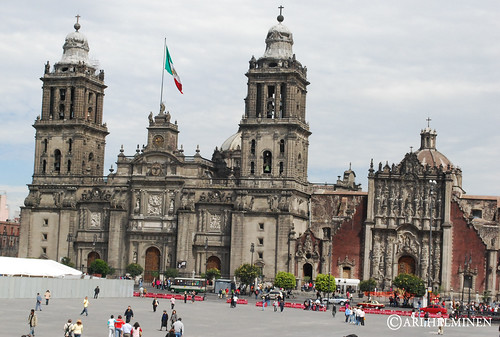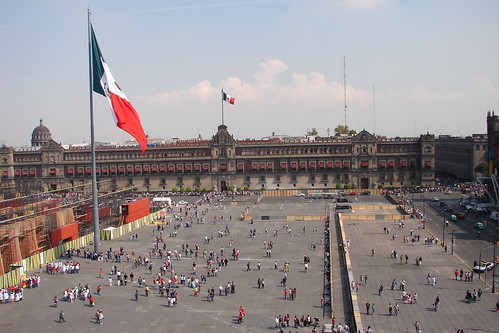No doubt the first impression of Mexico City (known as DF) intimacy is great, chaotic, incomprehensible. But after a few days, distances seem shorter and move through these winding streets where daily circulation of 24 million people.

Photography by Francisco Diez
Tourists usually stay in town just a couple of days before fleeing to the beach, but it’s worth stretching a little more stay to unravel a city steeped in history, museums, popular culture, festivals and traditions.
Then the new colony Rome, rejuvenated and trendy, the historic Zocalo, the center of the celebrations of the bicentennial, and a typical night of wrestling, three axes for immersing yourself in life authentically Mexican.
What’s new: Colonia Roma
The Roma is changed. He warns anyone and the naked eye, even that first visit to the city. These trendy bars, the gleaming hotel boutique, designer clothing stores, art galleries, and young atmosphere that hovers in the air we note that are new, a few years ago.
The Roma is fashionable. «Follow the antique dealers and gay and find the hot spots,» is what is being said and it seems that the formula does not fail, because Rome is the new place of immense DF also elected by gays to walk away from prejudice, in a city that accepts gay marriage.
The Roma, as they call here the neighborhood, was among the first to develop beyond the center, in the early twentieth century, in the days of Porfirio Diaz. They built large houses where families lived in upper-class elegance strolled through the wide streets. Over the years fell into decline and many houses were abandoned.

Photography by monterd
The great earthquake of 1985 broke down many buildings and many more people left the place. Even still see houses with cracked walls. As some went, others came: in the last 10 years attracted artists and writers landed in the place, with lots of green squares, low houses, neighbors always and very cheap rent.
This revived to become one of the most pleasant city to walk without the glamor of Polanco and a little less cool La Condesa. Here it is mixed with the bohemian cobbler years.
It’s Saturday afternoon, bars and restaurants are full, people walked slowly, and the flea market on Alvaro Obregon, the main avenue, with grand boulevard in the center, continues to offer a bit of everything.
An ideal evening to walk slowly and discover the best of Rome. You can start from Colima (between Tonala and Cuauhtemoc), the quintessential neighborhood street, with many businesses designer clothes and accessories, as Sicario, and galleries such as Vertigo, specializing in graphic design.
One of the new residents of the colony is the Brick Hotel, which opened just four months. It is a boutique hotel, too fashionable in Mexico, with 17 rooms and modern decor hundred percent Mexican.
Around the corner, at the corner of Orizaba and Alvaro Obregon, Casa Lamm, built in 1911, has a cultural center, art gallery and restaurant, but what really is the construction impact, with a huge staircase.

Photography by Patricia Díaz
A few blocks away, Plaza Rio de Janeiro, the prettiest neighborhood, with a huge fountain in the center, is colonized by a group of boy scouts children playing, shouting and having fun.
In the corner, Café Toscano, one of the star, invites you to relax in one of the tables on the sidewalk. In Rome, the frenetic D.F. goes to one side.

Photography by Fotosuabe
Typically: Wrestling
To unravel the D.F. from the side most popular choice is to see good wrestling. A sort of national sport (after soccer, of course) and show. For a foreigner will clearly show, well fitted for the occasion, but the Mexicans are passionate and at times the line between sport fighting and show quite confused.
Many are really fans. There are TV shows, magazines, a vast merchandising mask, costumes and puppets, and from just a few days until a video game, Heroes of the ring, putting on consoles Mexican wrestling.
Outside the Arena Mexico, one of the covered stadiums where matches are held on Tuesdays and Friday night, and feel the festive atmosphere in and around a soccer field.
The fighters already on the ring, people screaming and encouraging each other. Vendors sell beer, candy, snacks. A show for the whole family, although many more adults than boys. Start one of the fighting takes strange trios (all have names), high performance and a great display of acrobatics inside and outside the ring.
Most fighters are masked and keep their identity hidden like a secret that perpetuates the legend, but when there are personal rivalries (fictional or real who knows) are agreed struggles of betting, where you put your own mask in play. Losing is a disgrace, for many the end of the race, others follow, but openly.
The days of betting or hair mask, Arena exploits of people must get tickets in advance.
And you may find, for rivalry and Mystic Flying is just right. Flying, winner of the Bicentennial Cup, is willing to bet his mask to show that this is no game.
Beyond the end result, everyone comes out happy, looking for the mask or favorite doll sold hundreds in the door.
The historic El Zócalo
It’s one more night in Mexico City, seemingly nothing to celebrate, but the Constitution Square, better known as the Zocalo, a large open area with only one pole in the middle (day flamearía a huge Mexican flag), is busy .

Photography by aginorz
The children play with some toys that light fly through the air, big talk and eat some tacos, which are sold everywhere. A catrina (a very elegant and distinguished skull) is taking pictures with the few remaining tourists in the square. Because death is always present in Mexican traditions.
Opposite the cathedral is the stallholder’s street rampage. «Come, come,» the word spread among each other. The mice stuffed wag their tails on the floor finish in the bag seller, which disappears within seconds. Those who come are policemen who are permanently on the streets, especially at night.
A campaign by the Tourism Department tries to get rid of the stigma of unsafe city and to ensure that there is less crime in some U.S. cities. Beyond the police presence, the streets are poorly lit and intimidate those who are not used, but in the Zona Rosa, La Condesa or Polanco, you can ride with no worries at all times, and even travel by metro, which runs until nearly midnight.
A month ago, the Zocalo was made shrill scream, the bicentennial celebration of Independence. Because this is a year in Mexico native also much more patriotic than usual. On 15 September, met 200 years of the struggle of Hidalgo. Even the buildings around the square look with colorful Mexican cartels, which are lit at night. Bicentennial coins were minted, there are circuits allegorical specific historical and menus in restaurants, such as parental rules.

Photography by gripso_banana_prune
But in Mexico everything is big, this year also will celebrate the 100 years since the beginning of the Revolution led by Emiliano Zapata and Pancho Villa against Porfirio Diaz.
In the Zocalo is an electronic sign counting down the days until the November 20 celebration. Already preparing the celebration of 14 days, beginning on November 7, with 300 artists on the scene of the Zocalo, lights and projections on the buildings.
Around the square are the most important historical sites. We must return day. Among the captive, stands the cathedral, with five centuries of history, every year it sinks about three inches. Back where the ruins of the Aztec Templo Mayor, a museum tells the history of ancient Tenochtitlan. On another side, the National Palace, where you enter for free, you have to climb to see the stunning Diego Rivera murals that depict Mexico’s past.
One of the best ways to end the night is at the Café de Tacuba (Tacuba 28), one of the most iconic, founded in 1912, a few blocks from the Zocalo and order a chili Tacuba with a beer. The mariachis, with its traditional repertoire, they put music to share food. A not to get the orders for each item costs about $ 10.
Enjoy your trip!
One Response to “Mexico City Tours”
Leave a Reply
You must be logged in to post a comment.
marzo 18th, 2012 at 5:03 pm
[…] where in 1771 the Franciscans had settled Mission San Gabriel. Until 1846, the land belonged to Mexico. Later was annexed by the United States during the war between the two countries. In the following […]